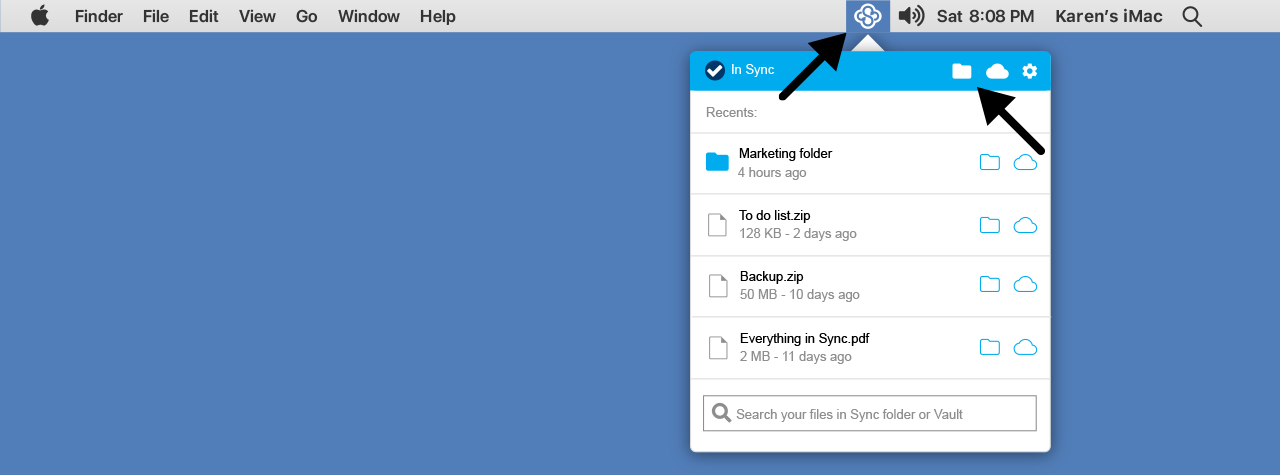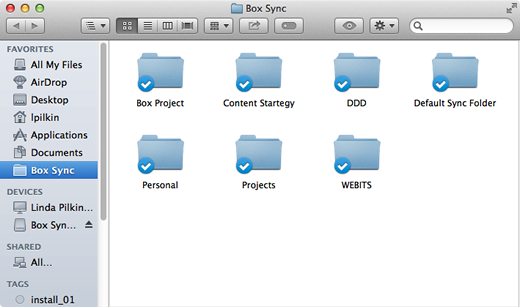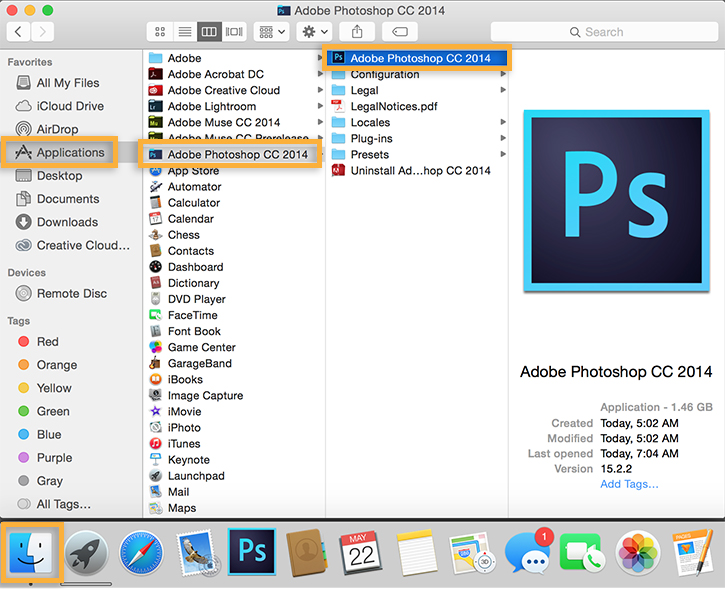Notebooks for Mac 2.1
Download Trial / Buy direct or from Mac App Store
This app automatically and continuously synchronizes the contents of your Dropbox (and with it the documents you sync from Notebooks on an iPad or iPhone) with a folder on your Mac. Select the Dropbox folder you use for synchronization from your iPad or iPhone as home folder for Notebooks on your Mac. By default, this folder is Dropbox. Download Folder Sync for macOS 10.10 or later and enjoy it on your Mac. Keep multiple pairs of folders in sync, quickly and easily. Great for backups and for managing content on USB drives, memory cards, and other computers/drives on your network.
Start creating documents with styles, attachments, tables and checklists, or drop any kind of document into Notebooks. File them in as many nested books as you need to structure your projects and details. Add task lists or simple checklists, divide large projects into nested sub projects, which makes them easier to handle, cross-reference into your reference library – which may be any book or document in Notebooks – and Notebooks for Mac may soon become the central repository for everything you want to keep close at hand.
Notebooks for Mac provides all the tools you need to concentrate on your work and be productive – on your Mac. Formatted documents, plain text and Markdown, the fullscreen modes, dark mode, multiple tabbed windows, breadcrumbing navigation, smart books, word count or the option to compile multiple fragments into a single document or eBook are just a few examples.
Of course you can synchronize the contents of Notebooks between your iPad, iPhone and your Mac, so you can seamlessly work on your documents on any device.
Notebooks 2
Notebooks for Mac 2 is a major update from Notebooks 1.4 with countless improvements and innovations. We rebuilt it from scratch with the goal to better integrate it with macOS, make it future proof and much extend its functionality. – Notebooks 2 is a paid upgrade for users of Notebooks 1.x.
What is New in Notebooks 2
- Notebooks 2 is now Mac native, so it fully integrates into the macOS environment, looks and works like Mac app.
- Open documents in separate windows or tabs. Notebooks remembers open windows and tabs between restarts.
- View and edit external documents by dropping them onto Notebooks‘ icon.
- Convenient document only and full screen modes with options to change the window’s background color.
- Each window shows a bread crumbing navigation at its top, which makes it easy to quickly navigate to any other document without using outline or document list.
- Support for Context tags including automatic extraction from documents.
- Smart books for Recent Items and Recently Modified items.
- Formatted documents now provide
- table support to create and edit tables,
- indented checklists with clickable checkboxes
- a Table of Contents which you can add at any position in a document and which updates as you edit the text,
- a wider selection of document styles
- Plain text documents can
- display line numbers,
- highlight the currently edited line,
- pin the current line to a specific position,
- sort selected lines,
- apply bottom overscrolling, etc.
- Markdown support has been improved, too
- Click a formatted Markdown document to immediately start editing at that position.
- MultiMarkdown is available as an alternative Markdown converter.
- Markdown checklists (
- [ ]) are supported with Notebooks’ default Markdown converter. The checkboxes can be toggled from the formatted view. - Wiki style links
[[]]with auto expanding file paths for setting the target.
- Allow Notebooks to automatically extract tasks from the contents of your documents.
- Import documents or snippets through the Share… menu or one of Notebooks’ Services.
- Compile documents and books to create a single editable document, an eBook or a PDF document.
- Option to hide Notebooks’ plist files in Finder.
- Import documents from Evernote with just a few clicks.
There is much more to discover in Notebooks 2. A look at the Version History reveals the changes in detail. Meanwhile we are working on and extending in app help and documentation.
Notebooks 2 requires macOS 10.11 or later, and for best experience, Spotlight should be enabled on the drive that is holding your documents.
FAQ – Notebooks for Mac 2
If you use Notebooks on an iPad or iPhone and synchronize its contents to Dropbox, it is easy to pick up and work on the same documents with Notebooks for Mac.
- If you have not already done so, download and install the Dropbox client for Mac, a free download from the Dropbox website. This app automatically and continuously synchronizes the contents of your Dropbox (and with it the documents you sync from Notebooks on an iPad or iPhone) with a folder on your Mac.
- Select the Dropbox folder you use for synchronization from your iPad or iPhone as home folder for Notebooks on your Mac. By default, this folder is Dropbox/Notebooks, located in your user home.

With this setup, Notebooks for Mac displays the books and documents from your Dropbox sync folder and saves all changes and modifications to that folder. The Dropbox client on your Mac then syncs these documents to Dropbox, from where they find their way into Notebooks on your iPad or iPhone. - Currently, this is the most convenient and seamless connection between Notebooks on your iOS device and your Mac.
One of the benefits of Dropbox compared to other services is its history of changes, reaching back at least 30 days. If something ever should go wrong, there is always an easy way to restore the original documents.
Notebooks 2 is a paid update, so it requires its own license. There are three options to obtain a license and unlock Notebooks 2:
- Purchase Notebooks 2 from the Mac App Store,
- Unlock the trial version of Notebooks by purchasing a license directly from within Notebooks 2.
- Purchase a license from this site and unlock Notebooks 2.

These are perpetual licenses which do not expire. There are no recurring fees.
With the release of Notebooks 2, Notebooks 1 has been discontinued; you can still use Notebooks 1 as long as you want, but it will not receive any updates.
When you first launch Notebooks 2.0 and it asks you for its Notebooks Home (the folder where its expects your documents), just point it to the same folder you are using as Notebooks Home in Notebooks 1.x.
Notebooks for Mac stores its documents are regular files in folders on your Mac. Since Notebooks 2 and Notebooks 1.x are compatible, a migration process is not necessary. You can even run Notebooks 1.x and Notebooks 2.0 side by side without any issues.

Once you purchase a license to unlock Notebooks 2, you can use it as long as you want, the license is 'yours'. There are no monthly or annual recurring fees.
- Export your Evernote notes in
.enexformat. - Move the resulting file into Notebooks. You can do so by dragging it into a book in Notebooks' outline or document list.
- Select the file in Notebooks.
- Notebooks displays some status info and an import button In the right window. Click that button to extract your notes contained in the enex file and add them to Notebooks.
- Wait until the process has finished and you are done. You can now continue to work on your documents directly in Notebooks.
The versions of Notebooks available from the Mac App Store and from our website are mostly identical, but due to the Mac App Store requirements there are a few minor differences. Apps sold through the Mac App Store need to adhere to macOS Sandboxing. This mechanism ensures that applications only access documents and folders that the user has explicitly selected. This selection is made when choosing a Notebooks Home.
Symbolic Links
The Mac App Store version Notebooks is not allowed to follow and resolve symbolic links if the link's target is outside of Notebooks' home folder or resides on a different partition. Folders seem empty and Notebooks displays their titles in a lighter color.
If you rely on hard links in Notebooks, we would recommend to download and use the versions available directly from our website.
Webarchives created in Notebooks don't open in Safari
Another side effect of Sandboxing: certain files created by applications are quarantined by macOS. When you double click to open them in Finder, macOS displays a warning and refuses to open them. – In the case of Notebooks, webarchives may be affected (they are created when you copy some formatted text and then choose New from Pasteboard).
To open these webarchives from Finder, right click on them, choose Open with > Safari, choose Open and enter your password. This removes the quarantine flag from the file, and from now on you can open it as usual.
If you are not afraid of using Terminal, you can use the following command which does not require your password:
xattr -d com.apple.quarantine <path/to/the/file>
Notebooks for Mac 2 provides a combined full text search and document filter in the footer of the document list (the second column).
- Filter the Current List
- As you start entering text in that field, Notebooks filters the currently displayed list and displays only the documents containing the given word or phrase in their title. This is handy when you look for a specific document in a long list: enter a few characters that are contained in its title to quickly turn up that document.
- The filter is available in regular books, but also in most of the smart books (even recent items and recently modified.) It operates on the list of currently displayed documents, so it does not look at the contents of nested books.
- To clear the filter and return to the regular list, just clear the text field.
- Full Text Search
- If you type return after entering the text, Notebooks starts a full text search. The scope of the search is by default limited to the current book (and the hierarchy below), but a checkbox right next to the search field allows you to change the scope to all books (that checkbox shows up as soon as Notebooks displays search results.)
- The search results appear as a list of documents, similar to the contents of a regular book. Notebooks does not display any preview for the search results, but displays the documents' paths instead.
- To clear the list of search results just clear the search field.
When you launch Notebooks you can influence some of its settings and behavior by pressing specific modifier keys:
- Holding down the cmd key keeps Notebooks from opening the last viewed document (the document that was last viewed before closing Notebooks).
- When you hold the alt key, Notebooks ignores the currently selected Notebooks Home folder and allows you to select a different folder.
If you receive a coupon code for Notebooks for Mac 2.0, you can redeem it when purchasing a license directly from us. You can get a license either from within the trial version of Notebooks 2.0 or through our web form. The process is identical in both cases.
On the screen which asks you to select the payment method, click Add Coupon and enter the code. The total sum then reflects the applied discount.
-->For the best performance, reliability, and user experience, follow these 'ideal state' recommendations when you configure the OneDrive sync app.
Updates and rings | Windows Notification Service | Files On-Demand and Storage Sense | Office integration | Silent account configuration | Known Folder Move |
|---|---|---|---|---|---|
| Allow traffic. Select some people for the Insiders ring and leave the rest in Production | Allow traffic | Keep Files On-Demand enabled and enable Storage Sense policies | Keep Office collaboration enabled | Enable the policy | Enable the policies |
Microsoft Folder Sync Tool
Updates and rings
- Allow access to oneclient.sfx.ms and g.live.com. Computers must be able to reach these URLs to apply updates and bug fixes, and enable or disable features. Updates are installed automatically, so you don't need to package and deploy them. Because OneDrive runs in the background, updates are also installed silently and don't impact users.
- Use the Insiders and Production rings. Select several people in your IT department as early adopters to join the Insiders ring and receive features early. Leave everyone else in the organization on the default Production ring to ensure they receive bug fixes and new features in a timely fashion. This recommendation applies even if you are on the Semi-Annual Channel for Windows and Office. For more info, see Sync app update process. To set the update ring on Windows, see Set the sync app update ring. To set it on Mac, see Deploy and configure the new OneDrive sync app for Mac.
Windows Notification Service
Make sure connection to the service is enabled. Work with your network team to make sure proxies:
- Allow network traffic to bypass *.wns.windows.com
- Avoid HTTPS decryption for *.wns.windows.com.
This applies to both Windows and Mac. See the complete list of required URL and IP address ranges.
Files On-Demand and Storage Sense
- Keep Files On-Demand enabled. OneDrive Files On-Demand helps users access all their files (individual or shared) without having to download them and use storage space. This setting is on by default for Windows 10 and Mac. To check this setting for Windows, see Use OneDrive Files On-Demand. To check it for Mac, see Deploy and configure the new OneDrive sync app for Mac.
- Use Storage Sense policies on PCs. These policies let you automatically clean up 'locally available' files users haven't explicitly pinned as 'always available'. More info about Storage policies
Office integration
Free File Sync For Mac
- Keep Office file collaboration enabled Office uses differential sync to sync only changes instead of the entire file each time. This makes sync faster and reduces network bandwidth. This setting is on by default on Windows and Mac. For more info, see Coauthor and share in Office desktop apps. For info about this setting for Mac, see Deploy and configure the new OneDrive sync app for Mac.
Silent account configuration
- Silently configure user accounts on PCs. When you enable the silent account configuration policy, users are signed in automatically so they don't need to open OneDrive or enter their password. For more info, see Use silent account configuration.
Known Folder Move
Folder Sync App For Mac Windows 10
Windows users are familiar and comfortable with saving files to their Desktop, Documents, and Pictures folders from years of developing it as a habit. When you redirect and move these folders to OneDrive, users can continue saving files to these locations and they're backed up and available from any device. For more info, see Redirect known folders.
- On new PCs, enable the silent policy. Silently move Windows known folders to OneDrive
- On existing PCs, gradually enable the prompt and/or silent policy. About the Known Folder Move Group Policy objects